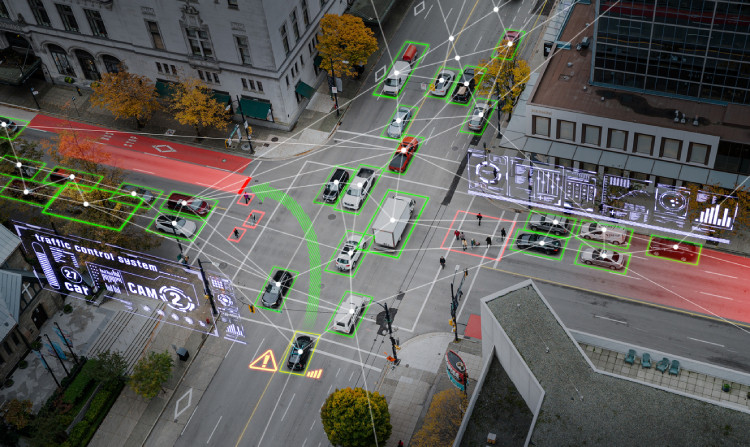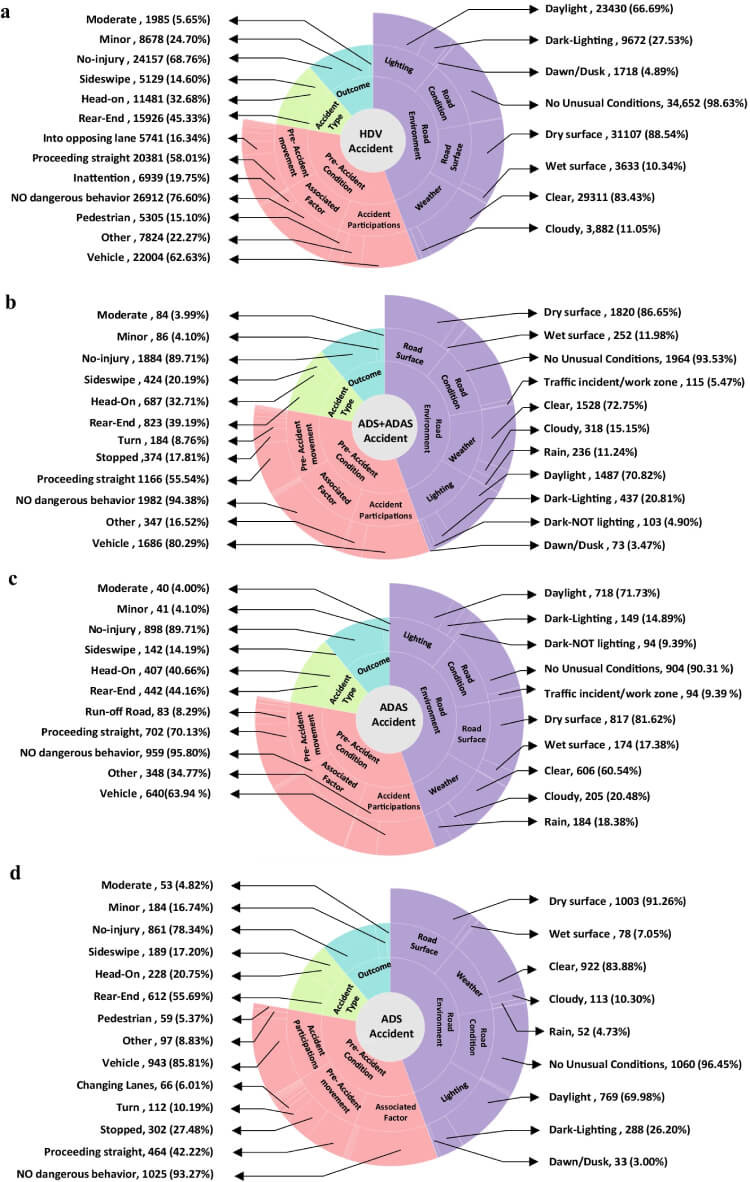Are Autonomous Vehicles Really Safer than Human Drivers?
Technical Analysis | 02-08-2024 | By Liam Critchley

Key Things to Know:
- Automation in the automotive industry, particularly through Autonomous Vehicles (AVs), aims to reduce human error, which accounts for approximately 90% of traffic accidents.
- Advanced Driver Assistance Systems (ADAS) such as Electronic Stability Control (ESC) and Anti-Lock Braking Systems (ABS) significantly enhance vehicle stability and safety in AVs.
- Studies suggest that AVs could potentially save up to 600,000 lives in the United States over 35 years by introducing enhanced safety features.
- However, AVs face challenges in complex scenarios like dawn/dusk driving and turning at intersections, where they have higher accident rates compared to human drivers.
Introduction
Automation of modern-day technology has become a common sight and aims to make our lives easier. Automation has undergone rapid developments and has brought a technological revolution to the automotive industry in the form of autonomous vehicles (AVs). AVs have provided an attainable futuristic vision where transport can be safe and autonomous, potentially freeing humans up from the need to drive.
It's thought that AVs will be able to reduce the number of accidents on the road because current estimates state that human errors are responsible for around 90% of traffic accidents. However, trying to bring the future to the present is no easy task, and AVs have had their fair share of setbacks, which is why we do not routinely see them on the road en masse.
While AVs have the potential to improve the safety and operation of vehicles, one of the main drawbacks of current AV technology is their perception of safety risks, where on-road accidents of AVs have already been documented in limited testing data. However, one of the key questions remains: which one is safer on our roads, human-driven cars or AV cars?
That is still an open-ended question, with studies looking at both sides of the coin. Depending on the factors that are being measured with respect to safety, some studies say AVs, while other studies say humans. Here, we look a bit more at how and why there is ambiguity in which one is the best.
Where AVs are Safer than Humans
AVs bring several benefits over human drivers when it comes to traffic safety, including a reduction in human error, distraction and fatigue. AVs also employ Electronic Stability Control (ESC), Anti-Lock Braking (ABS), and Information and Communication Technology aids whilst driving to prevent accidents.
Moreover, AVs are equipped with advanced driver assistance systems (ADAS) such as Electronic Stability Control (ESC) and Anti-Lock Braking Systems (ABS), which significantly enhance vehicle stability and safety. Studies show that these systems help in maintaining lane discipline and preventing potential accidents caused by human errors.
One real-world example of this the Autopilot functions in Tesla cars, which consistently maintain a closer distance to the centre of the lane than human drivers do. Further levels of automation could help to reduce accidents, reduce fatalities from people crossing the road, and minimise traffic collisions by removing human errors that are typically the cause of many accidents—often due to drivers being distracted.
Where do AVs need to Improve?
Despite being safe in some respects, there are some areas that need to be addressed in AVs. One of the main challenges is finding technologies that enable the AV to have reliable sensing and perception. Other examples that need to be improved include robust decision-making algorithms and fail-safe mechanisms.
To further understand the nuances in safety between Autonomous Vehicles (AVs) and Human-Driven Vehicles (HDVs), it is essential to look at the data comparing their accident rates under various conditions. Recent studies, such as the one by Ding and Abdel-Aty, provide comprehensive insights into these dynamics. The figure below illustrates the distribution of factors influencing accidents for AVs and HDVs, highlighting significant disparities in accident scenarios and outcomes.

Figure 2: a: Human-Driven Vehicle (HDV) accidents with a sample size of 35,133, b: SAE Level 4 Autonomous Driving Systems (ADS) and SAE Level 2 Advanced Driver Assistance Systems (ADAS) accidents with a sample size of 2,100, c: SAE Level 2 ADAS accidents with a sample size of 1,001, d: SAE Level 4 ADS accidents with a sample size of 1,099. (Click to enlarge)
Statistical models have shown that estimating the reliability of AVs would require AVs to be driven for hundreds of millions of miles—if not hundreds of billions of miles—to determine their reliability in terms of fatalities and injuries. This does bring some level of ambiguity into some safety aspects of AVs, but the models have suggested that AVs would only be responsible for 382 accidents per 100 million miles, but without physically doing the miles, the reliability is determined by models.
Kalra and Paddock's research underscores the necessity of extensive real-world testing, estimating that AVs would need to cover hundreds of billions of miles to statistically demonstrate their reliability. This highlights the challenge in ensuring the safety of AVs purely through theoretical models.
It has been suggested that improvements in safety features within AVs could yield significant life-saving results. It's been modelled that if AVs had a safety level 10% above that of your average human driver, then around 600,000 fatalities could be avoided in the US alone over 35 years.
Insights from California's AV Testing Data
There have been some recorded AV tests since 2015 in California that provide some insights into AV accidents. Between 2015 and 2022, it was shown that there was a yearly rise in both the annual miles travelled by AVs and the number of accidents they were involved in. The only exception throughout these years is 2020, but this decline has been attributed to the COVID pandemic and the subsequent lockdowns that meant that fewer people were out and about. California has been able to provide some limited insights into the correlation between mileage vs accidents because the local laws permitted by the California Department of Motor Vehicles allow for AV testing on public roads.
Furthermore, the data from California's Department of Motor Vehicles reveals significant insights into AV accidents. From 2015 to 2022, 598 ADS accidents were reported, primarily occurring during mode transitions or when operators assumed manual control for safety reasons. This data is crucial for understanding the operational risks and areas for improvement in AV technologies.
California has so far identified 598 Advanced Driving Systems (ADS) accidents within the state. It has been found that the accidents have occurred in two main scenarios. The first is when the vehicle switches from autonomous mode due to technological issues, and the second is when the test driver/operator take manual control for safety purposes.
Which one is Technically Safer?
Because many studies either sit one way or another depending on what's been measured, the jury is still out on the answer with modern-day AV technology, but that may change in the future as the technology gets more advanced and better safety features are introduced.
For example, studies have looked at the accident rates of Google's self-driving cars and compared them to human drivers. These studies have shown that accidents involving Google cars are less fatal than accidents caused by a human driver. Within this, no fatalities have been reported for Google cars, compared to 1 death per 108 million miles in California for human drivers. Earlier studies looking at AVs from 2009-2015 in California showed that Google cars also have a lower rate of police-reportable accidents compared to humans—more specifically, 2.19 reports per million vehicle miles travelled (VMT) for AVs compared to 6.06 reports per VMT for human drivers.
Additionally, Koopman and Wagner emphasise the importance of understanding AV interactions with human drivers, pedestrians, and other road users. Enhanced algorithms and sensor fusion technologies are vital for improving AV performance in diverse and dynamic driving conditions.
However, other studies have suggested that human drivers might be safer than AVs. In these studies, it's been proffered that humans have a lower rate of accidents per VMT than AVs in less demanding driving environments, i.e. avoiding snowy areas and other harsh/difficult driving environments. Studies have also shown that the way AVs stop on the road can lead to accidents with non-AV vehicles. Studies have shown that rear-end collisions are the most common accident type for AVs, with AVs being rear-ended at twice the rate of human-driven vehicles.
Comparing Accident Rates Between AVs and Human Drivers
A recent study from Ding and Abdel-Aty has looked at information from 2100 ADS and Advanced Driver Assistance Systems (ADAS) AV vehicles, as well human vehicle accident data, to look at the occurrence of AV accidents compared to human-driven vehicles. The overarching finding is that the AVs which are equipped ADS generally have a lower chance of being involved in accidents than human drivers in most accident scenarios.
A matched case-control study conducted by Ding and Abdel-Aty analysed 2100 ADS and ADAS vehicle accidents compared to human-driven vehicle accidents. The study concluded that ADS-equipped vehicles generally have a lower accident rate in most scenarios, yet they face challenges in complex situations like dawn/dusk driving and turning at intersections.
However, this doesn't tell the whole story. The study showed that accidents with AVs occur more often than human drivers at dawn/dusk and in turning conditions. At dawn/dusk, AVs were found to cause over 5 times more accidents than human drivers, and cause almost twice as many accidents whilst turning. It's thought that these accident numbers are so high in these complex scenarios due to AVs having limited driving experience and a lack of situational awareness.
Overcoming this shortcoming is going to require advancements in advanced sensors (weather and lighting sensors), implementing robust algorithms and redundancy measures, integrating sensor data effectively, and smart design considerations. The recent study took a different approach by analysing both AV data and human driver data against each other to compare accident rates, whereas many other studies focus on the different levels of AV accidents without comparing them against equivalent human driver scenarios.
As it stands, there are a lot of factors that need to be considered to make a definitive decision, and we're not at that stage yet. Some studies looking at certain safety aspects put AVs as the safest choice, whereas others look at the shortcomings of AVs to show how human drivers are safer in certain driving scenarios. One thing is for certain, and that's that the technology is nowhere near the highest state of maturity that it could theoretically reach, and it's already causing ambiguity as to which is the better way of driving. In the years to come, and as AV technology becomes more advanced and safer, the pendulum could well swing to the point where AVs are considered a much safer choice than human drivers.
Reference:

